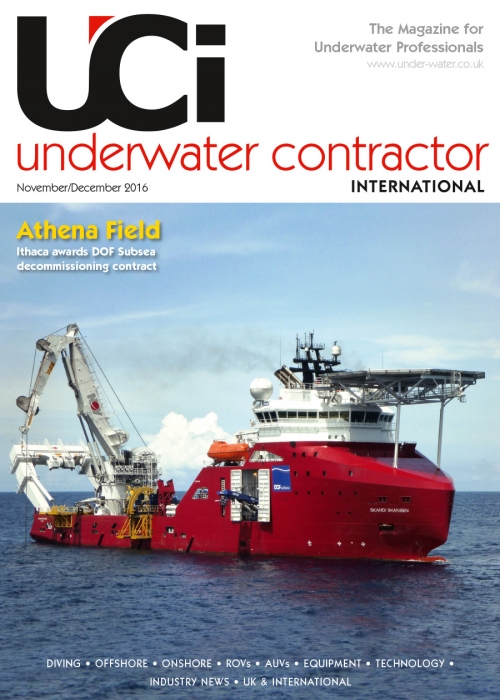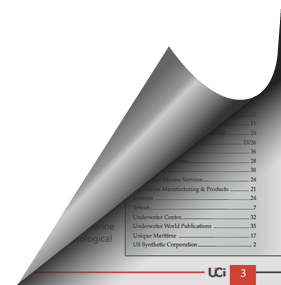
The Magazine for Underwater Professionals
![]() Nov/Dec 2014
Nov/Dec 2014
ASSOCIATION NEWS
Society for Underwater Technology
Lessons learned from diving activities in the extreme environment of the Sakhalin Island
The SUT North of England Branch evening meeting for September 2014 took place at the International Centre for Life in Newcastle with the topic ‘A Day in the Life’. Michael Williams, managing director of PDL and chairman of the event, welcomed the participants and made a short introduction about the aims of the Society. The meeting had two sessions and three speakers, who were introduced to the audience.
The first session started with a talk given by Phil Roberts, principal subsea engineer at Strongwork Engineering, who presented the lessons learned from diving activities in the extreme environment of the Sakhalin Island project in Russia. Phil, having diving and ROV intervention experience of 41 years, discussed all the difficulties that had to be faced for the safe operation of the diving facilities and the safety of the divers in the harsh semi-arctic environment.
REMOTE
Sakhalin Island is a remote area with low population density and poor infrastructure and is located in a highly seismic area. The local weather conditions usually consist of very low temperatures, offshore ice, fog and significant wave actions that make any offshore operation even more challenging. Also, the island is rich in offshore and onshore wildlife, a parameter that resulted in significant changes in the operational planning and routing of the oil and gas transportation pipelines.
The Sakhalin project was divided into two phases.
Phase one of the project involved the development of crude oil production facilities on the Astokh feature of the Piltun Astokhskoye field. The Molikpaq offshore oil production platform forms the central feature of the Vityaz production complex, which also consists of a single anchor leg mooring (SALM) buoy and the Okha floating production storage and offloading (FPSO) vessel. Oil produced from the Vityaz production complex is then transported by subsea pipeline to the SALM and FSO where it is transferred to shuttle tankers for sale to customers.
During Phase two of the project, the Molikpaq platform will be connected to the new pipeline infrastructure to enable year-round production.
SUPPLY
The exploitation of this world-class gas reserve was the first offshore oil production project for Russia and it is a strategic and reliable energy source that offers supply diversity in the heart of Asia, as well as to the US West Coast. The project has also demonstrated world-class safety and environmental performance with oil spillage of less than 27.5 litres since the start of operations.
As far as diving issues are concerned, the project contained several challenging actions. More specifically, air diving was used on Molikpaq in support of the SALM operations (raising and lowering) and general SBM duties. Construction diving support for the pipeline lay and tie-in was also provided along with sat diving for the tanker loading unit tie-in. Air diving operations took place for the support of the LNG jetty as well as for the civil works at the LNG plant. Finally, UXO diving operations took place for the removal of unexploded ordinance.
Diving in these waters was a challenging task for the divers. Most of those that were trained and experienced in only warm water were quitting after the first dive due to the harsh weather conditions and very low temperatures. In addition, standard operational equipment had to be used in the extreme environment, which required the upgrade of the equipment to account for the low temperature effects and safety issues had also to be considered.
The second talk of the evening was given by Brad Dillon, master mariner and section leader with Maersk Drilling. Brad gave an insight into the everyday life as an assistant marine section leader and barge engineer. He described the difficulties of his job, mainly related to space limitations, constantly changing space and load requirements on the rig, the need of coordinating several crew teams with multicultural origin and often the bad weather conditions. Commuting to the offshore work location every 28 days also takes a lot of his time and often requires the use of several means of transportation including planes, taxis, and helicopters.
HANDLE
The rig move process is another challenging task he has to handle. Since there is no propulsion mechanism in the majority of the units, the use of towing vessels and anchor handlers is inevitable. Before going in the water, the unit has to be prepared in terms of securing everything on board and releasing the legs from the seabed. When the final destination is reached, manoeuvring is executed carefully by the towing vessels and by employing the rig legs. When the rig is well-positioned for operation, the rig legs are lowered and the rig hull is elevated. The evaluation of the load bearing capacity of the soil under each leg is another delicate process. Failures attributed to misevaluations of the soil capacity (punch through/ scouring) can be catastrophic for the rig itself.
The last talk of the evening was given by Alex Roff, engineering director of PDL Solutions (Europe) Ltd, in the technical session of the event. Alex presented an overview of the ISO13628-7 standard and its application on the assessment of the capacity of a connector. ISO13628-7 covers both global riser analysis as well as local analysis and it is identical to the API RP 17G standard.
CONNECT
The main purpose of a connector is to connect adjacent components in the riser system to create a structural joint resisting applied loads and preventing leakage. Its capacity is compared with the parent pipe capacity under tension, bending and pressure loads. In the specific analysis several load levels were introduced that corresponded to different loading conditions (normal, extreme and accidental). For each loading condition, the combined effect of the applied loading was compared against the capacity evaluated using the code provisions.
The analysis of the connector also focused on the geometric effects in terms of tolerances and wear, the use of elastic or elastic-plastic material properties and friction effects and a comparison between the results of a 2D versus a 3D analysis was also provided. The numerical model was developed in a parametric way using analysis macros which controlled the material and mesh properties, the applied loading and the boundary conditions. The analysis results were evaluated against local and global criteria related to the developing strains in the teeth and other areas of the connector, as well as functionality criteria related to leakage and teeth disengagement. Finally, the capacity of the connector under each loading condition was compared with the corresponding code limit.
At the end of the presentations the audience had the opportunity to pose questions to the three presenters. After the discussion Michael Williams thanked the speakers and all the attendees enjoyed a buffet and networking opportunity.
George Varelis and John Farrer
The latest chapter in the successful Gadgets and Widgets (G&W) programme was delivered by the Aberdeen Branch in September at the Hilton Treetops Hotel. Chaired by Jim Mann, global ROV manager for Fugro Subsea, the evening saw nine quick-fire presentations delivered to an interested audience of 90 industry observers in just over 90 minutes.
First up was Ben Bennett, chief technology officer of Digital Surveys, who engaged the audience with a look at the world of close range laser scanning and the ability to interpret the cloud point dataset to produce as-built 3D models of complex structures – unfortunately it is currently a topsides process of subsea hardware prior to deployment, but we know people are working on subsea versions of this technology. Next up was SIG (Subsea Integrity Group), a spin-out from Genesis Oil and Gas Consultants. Chris Agar delivered a presentation on the Integrated Cleaning and Inspection Pig (ICIP), which adds an electromagnetic sensor system to a conventional cleaning pig, thereby allowing in-line inspection during routine cleaning operations. Stretching the point for a gadget or a widget was Simon McManus, vice president of research and development at McDermid, which is better known for delivering fluids to the drilling sector. Simon introduced a novel de-calcification chemistry that has been successfully deployed for cleaning external areas, e.g. seal faces of subsea equipment.
MEASUREMENT
Eric Siegel, managing director of Nortek Piezo, was then telling the audience about the latest developments in broadband transducer technology, which are now pushing the boundaries of acoustic measurement and enabling subsea monitoring innovations such as current velocity measurements over the 1000-metre range – vertically up or down. Next at the lectern was Stephen Ashley, the sales manager for Prevco Subsea, who had the best example of a “widget” on the night – a simple ROV/diver operable on-off switch. The simple rotary switch was developed to allow battery power to be saved on subsea deployed equipment and included such features as a full 360-degree rotary mechanism, which allowed the switch to be either on or off, but not stuck inbetween. Ioseba (Joe) Tena, sales manager of SeeByte, presented the benefits of mosaicing multibeam imaging sonar data in aiding ROV pilots, especially when combined with navigational data.
Trelleborg Offshore UK sent its new product development manager, Austin Harbison, to present on the approach it has adopted to the problem of working one step removed from the end customer for the installation of distributed buoyancy as used on subsea risers. The development included new tools and processes to ensure the clamp make-up was safe, efficient and simple – especially when taking account of the adverse working environment where the product was being deployed. Ian Crowther, executive vice president of WFS Technology, showed off the company’s Seatooth Pipelogger, including its use in a number of innovative applications designed to support asset integrity management by identifying thermal fatigue issues in a pipeline and highlighting the potential risk of upheaval buckling.
OVERLAID
The final presentation was a last minute substitution in place of Andreas Boenisch from Innospection, who was called away at the last minute. Stepping into the breach was Tim Rhodes, technology development manager at Fugro Subsea Technologies, who brought along an insight into the use of augmented reality (AR) that is being deployed in the Fugro work-class ROV fleet. AR provides additional information to the ROV pilot, especially useful in areas of restricted visibility or where prior field data can be overlaid onto a live video feed to enhance the data quality for the clients.
All of the presenting companies joined the Branch annual sponsors in making the evening both interesting and financially sound for the Society. Given the level of discussions and debate that ensued over a hot supper provided by the hotel, it looks like the G&W session will continue to be an annual feature of the Aberdeen Branch calendar. Presentations and contact information on all of the companies involved in the evening are available on the SUT website.
Jim Mann


